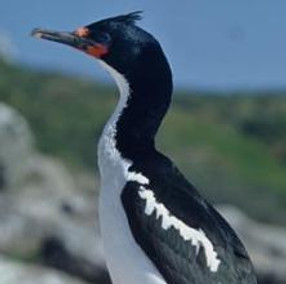Birds

Antipodean albatross (Diomedea antipodensis antipodensis)
Antipodean albatross spend the majority of their lives at sea, only returning to the Antipodes Islands to breed every second year. More recently, their foraging distances have expanded with foraging occurring along the continental shelf off Chile and the eastern coast of Australia. It is these long periods at sea which pose the greatest threat to the birds.
The current decline in this Nationally Critical species has been partly attributed to climate change. Warmer sea surface temperatures and altered wind and rainfall patterns both offshore and on land cause increased exposure and heat stress to chicks, and make foraging for food more difficult, due to changes in the movement and abundance of their prey species.

Black-billed gull (Larus bulleri) Tarapuka
Black-billed gulls mostly breed in colonies on the banks and islands of braided rivers in the South Island of New Zealand. These constantly changing habitats are created and destroyed by changing water flows.
Even though current estimates of black-billed gulls are of more than 30,000 pairs, this number has declined by over 70% over the last 30 years leading to their sudden classification as a Nationally Critical endangered species. They are now the rarest of the world’s gull species. The reasons for their dramatic decline in numbers are poorly understood, with many possible causes.

Black robin (Petroica traversi)
In 1980 only 5 birds remained, all on tiny Tapuaenuku/Little Mangere Island in the Chatham Island group. The species would be extinct today if not for the incredibly hard work of a team of conservationists, led by the late Don Merton, who overcame obstacle after obstacle in one of the most intensive conservation programmes in the world.
The successful conservation programme continues today, with island biosecurity to protect the 250-300 birds from pests.

Chatham shag (Leucocarbo onslowi)
The Chatham shag, endemic to the Chatham Islands, is curiously known for thieving nest material from its neighbours. Despite being related to the Otago and Foveaux shags, the Chatham shag’s biology and the reasons for the recent drop in numbers of nesting birds are poorly understood.
While research into the shag’s biology, ecology and survival rates is needed, practical steps can be employed now, including fencing breeding colonies from seals and livestock, predator control and promoting the use of shag-safe crayfish pots.

Eastern rockhopper penguin (Eudyptes filholi)
One of New Zealand's most numerous endangered species, numbering approximately 100,000 pairs on the Subantarctic Antipodes, Campbell, Auckland and Macquarie Islands. However, rising sea temperatures may be affecting food supply and the numbers of birds is falling fast.
Their numbers strongly reflect ocean conditions, which are forecast to become more variable as a result of climate change. Increased time spent foraging at sea increases the vulnerability of chicks left in the breeding colonies. Further research is needed on the Subantarctic food web, and the role of penguins within it.

Gibson's antipodean albatross
Endemic to the Subantarctic Auckland Islands archipelago, these ocean foragers make lengthy trips over the Tasman Sea and Pacific Ocean risking not only their lives but the lives of their chicks. Following the adoption of seabird-safe fishing techniques, the numbers of albatross being caught has reduced. However, the loss of even a few individuals may not be sustainable in a long-lived species such as this, especially now that they are so rare.

Little spotted kiwi (Apteryx owenii)
The little spotted kiwi is the smallest of all kiwi species, and may once have been one of New Zealand’s
rarest birds, without anyone noticing. Now that its population is secure on offshore islands and one fenced
mainland sanctuary, it is being returned to other islands and protected sites on the mainland, as far south
as Fiordland.
